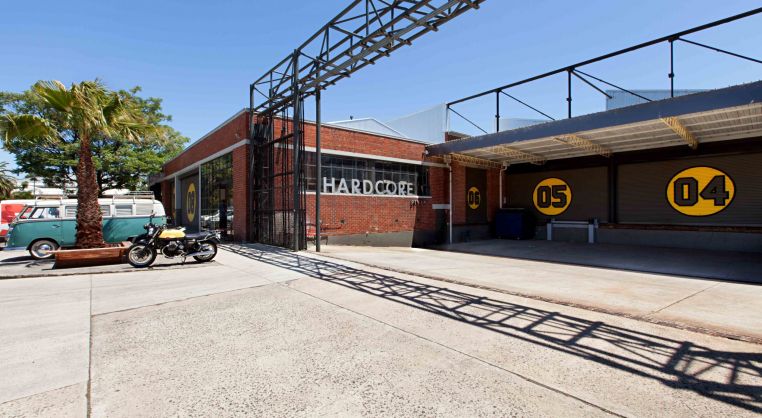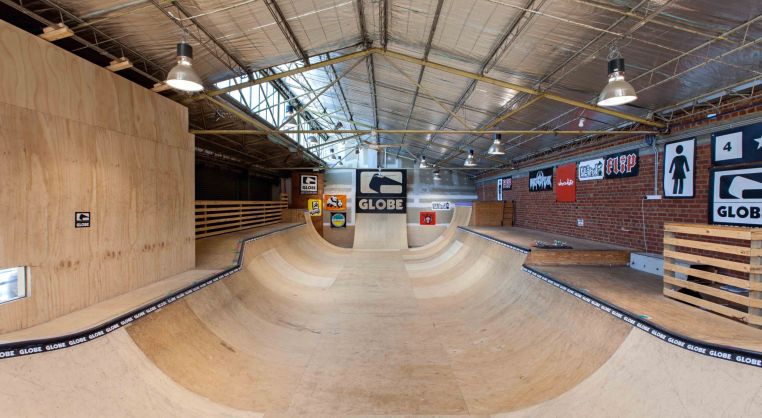This commercial redevelopment of the former Red Tulip Easter egg factory in Port Melbourne accommodates nine tenancies across a range of sizes, with Globe International as the anchor tenant. The reuse includes new industrial functions and maintains the fabric and industrial aesthetic throughout.
The large, well lit spaces are reused as open plan offices, warehousing, a film production studio and a boutique brewery. A band of smaller studio tenancies is located on the south-eastern edge of the building, while a cafe and shop enlivens the street edge on the southern corner.
The facility was developed in response to Globe’s requirements, with other areas leased subsequent to the development. Tenants were identified who would help generate a “creative hub”. Masterplanning was undertaken by Insite, who also designed the offices and warehouse for Globe, the film production studios, and the smaller studios leased subsequently. Design of some other tenancies was completed separately. The overall planning and permit application for the Matilda Bay Brewing Co was also undertaken by Insite with the design of the bar being undertaken by Di Mase Architects.
Download a printable version of the 1 Fennell Street case study (PDF 465 KB).
Site history and heritage
The factory was built in 1950 to make Red Tulip Easter eggs. Subsequently, a transport company used the cool store component for storage.
When the current project started the building was neglected but in good structural condition. Little work had been done on it since its construction.
The building is not heritage listed.
Opportunities
The building shell was untouched and housed large spaces under a steel truss, sawtooth roof.
The principal tenant, Globe International, Globe International designs and distributes skateboards and skate gear and actively sought an industrial environment for its office, warehousing, a showroom and skate ramp. The building was purchased and developed for this purpose by a development company partly owned
by two of Globe’s directors.
The zoning conditions at the time of purchase favoured retaining and upgrading the building for industrial, commercial and hospitality reuse. However, zoning changes may now mean that land costs have increased to the extent that a higher yield would be expected, making this kind of redevelopment more difficult.
Challenges
The ceiling and roof contained asbestos. Retaining the building’s industrial qualities while providing the comforts expected of a contemporary office was difficult – particularly in terms of insulation, improving energy efficiency and preventing draughts from the steel-framed windows. The project was completed in a very tight time frame – six months including the Christmas shutdown period.
Approach and outcome
The project aimed to retain the fabric and structure of the building and to maintain the feel of the space.
Roofing was replaced and ceilings removed to leave an exposed steel-truss, sawtooth roof above the large, light-filled volumes.
Building fabric – brick walls, steel-frame windows and timber floors – was left “as found” wherever possible and “not scrubbed up”. Rough or inconsistent finishes were celebrated and new materials were selected to complement the fabric. New works were designed as subtle elements within the shell.
Existing elements and fittings were also reused, including doors, windows and sanitary fittings. The Salford Lad’s Club cafe reuses trolleys from the chocolate factory in its kitchen.
Reuse continues in the office fitout, with much of the internal joinery coming from an earlier 2006 fitout for the company, also by Insite. The project was completed through a close collaboration between clients, designers, tenants and builders. The separate design of the brewery tasting room also pursued an industrial aesthetic – “as if the brewers had built their own bar from materials at hand” – and uses materials such as coolroom panelling in unusual ways.
Lessons
- The developer and tenants were looking for an industrial aesthetic, which meant that the qualities of the building were maintained.
- The mixed use program is compatible with the existing building and includes new industrial uses (brewery and warehousing) along with smaller scale uses.
- An excellent example of how a disused industrial building can play a part in urban regeneration. This is particularly relevant in the context of Fishermens Bend, an area slated for major redevelopment in the
near future.
Project team
Design concept and masterplanning: Insite with Peter Hill, Steve Hill and Greg Saunders. Builder and interior design: Insite. Structural engineer: David Novak. Matilda Bay Brewing Company bar fitout: Di Mase Architects.




